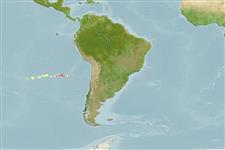Klassifizierung / Names
Namen | Synonyme | Catalog of Fishes(Gattung, Arten) | ITIS | CoL | WoRMS | Cloffa
>
Stomiiformes (Lightfishes and dragonfishes) >
Phosichthyidae (Lightfishes)
Etymology: andriashevi: Named in honor of Anatoliy Petrovich Andriyashev, outstanding ichthyologist and taxonomist on his 80th birthday..
Environment: milieu / climate zone / depth range / distribution range
Ökologie
seewasser bathydemersal; tiefenbereich 545 - 600 m (Ref. 41740). Deep-water
Southeast Pacific: known only from two seamounts of the Sala y Gomez Ridge and southeastern Pacific.
Size / Gewicht / Alter
Maturity: Lm ? range ? - ? cm
Max length : 20.9 cm SL Männchen/unbestimmt; (Ref. 41740)
Kurzbeschreibung
Morphologie | Morphometrie
Rückenflossenstacheln (insgesamt): 0; Rückenflossenweichstrahlen (insgesamt): 11-13; Afterflossenstacheln 0; Afterflossenweichstrahlen: 29 - 31; Wirbelzahl: 45 - 46. Pyloric caeca 7-8; photophores above anal fin 16-17; presence of 9 photophores in both ventroanal series and 20 trunk vertebrae (Ref. 41740).
Life cycle and mating behavior
Geschlechtsreife | Fortpflanzung | Ablaichen | Eier | Fecundity | Larven
Parin, N.V. and O.D. Borodulina, 1990. Survey of the genus Polymetme (Photichthyidae) with a description of two new species. J. Ichthyol. 30(6):108-121. (Ref. 41740)
IUCN Rote Liste Status (Ref. 130435)
Bedrohung für Menschen
Harmless
Nutzung durch Menschen
Mehr Information
NamenSynonymeMetabolismusRäuberÖkotoxikologieFortpflanzungGeschlechtsreifeAblaichenSpawning aggregationFecundityEierEientwicklung
Alter/GrößeWachstumLänge-GewichtLänge-LängeLängenhäufigkeitenMorphometrieMorphologieLarvenLarven Pop.Dyn.RekrutierungDichteBRUVS
ReferenzenAquakulturAquakultur ProfilZuchtlinienGenetikElectrophoresesVererbbarkeitKrankheitenVerarbeitungNutrientsMass conversion
PartnerBilderStamps, Coins Misc.LauteCiguateraGeschwindigkeitSchwimmstilKiemenoberflächeOtolithsGehirngrößeSehfähigkeit
Tools
Zusatzinformationen
Download XML
Internet Quellen
Estimates based on models
Preferred temperature (Ref.
123201): 11.1 - 11.4, mean 11.2 °C (based on 7 cells).
Phylogenetic diversity index (Ref.
82804): PD
50 = 0.5156 [Uniqueness, from 0.5 = low to 2.0 = high].
Bayesian length-weight: a=0.01000 (0.00244 - 0.04107), b=3.04 (2.81 - 3.27), in cm total length, based on all LWR estimates for this body shape (Ref.
93245).
Trophic level (Ref.
69278): 3.5 ±0.5 se; based on size and trophs of closest relatives
Widerstandsfähigkeit (Ref.
120179): mittel, Verdopplung der Population dauert 1,4 - 4,4 Jahre. (Assuming tm=2-4).
Fishing Vulnerability (Ref.
59153): Low vulnerability (16 of 100).
